Leadership Integration Project Deliverable Report: Unilever Analysis
VerifiedAdded on 2021/06/15
|21
|5888
|28
Project
AI Summary
This project, a leadership integration deliverable, provides an in-depth analysis of leadership principles within the context of Unilever. It begins with an introduction outlining the importance of competent leadership in modern business, followed by a background of Unilever, its structure, and its operations. A case illustration highlights challenges related to market dominance and internal capabilities. The project then reviews relevant literature on leadership, including transformational leadership, value-based leadership, and ethical leadership, alongside team leadership and visioning/strategy. The application of these theories and frameworks to Unilever's context is explored, with a focus on leadership skills. The project emphasizes transformational leadership and its impact on organizational performance. The analysis covers leadership competencies, the significance of ethical leadership, and the integration of vision and strategy. The project provides a synthetic summary of the findings and concludes with implications for personal action and a personal action plan, followed by a bibliography of cited sources.
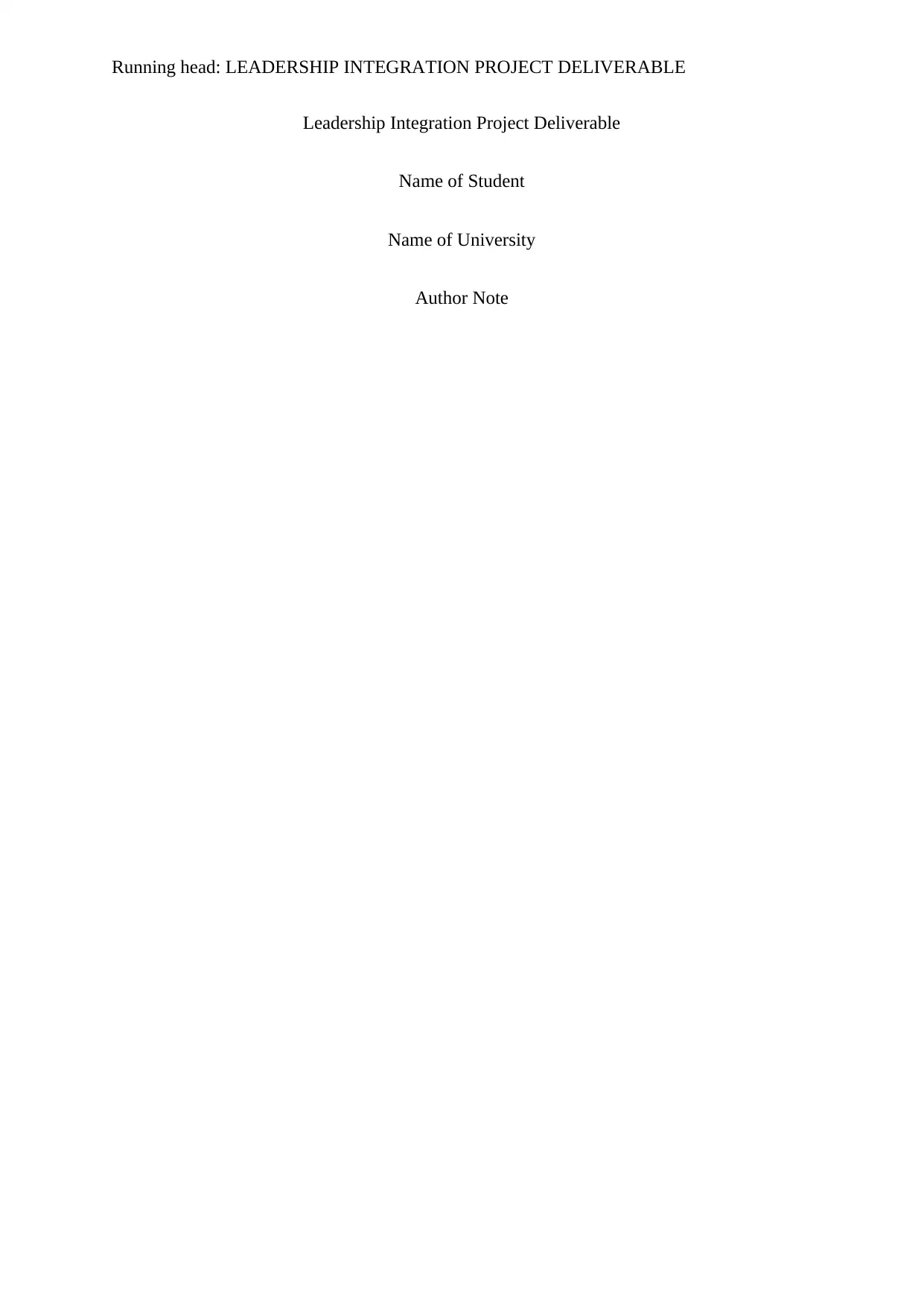
Running head: LEADERSHIP INTEGRATION PROJECT DELIVERABLE
Leadership Integration Project Deliverable
Name of Student
Name of University
Author Note
Leadership Integration Project Deliverable
Name of Student
Name of University
Author Note
Paraphrase This Document
Need a fresh take? Get an instant paraphrase of this document with our AI Paraphraser
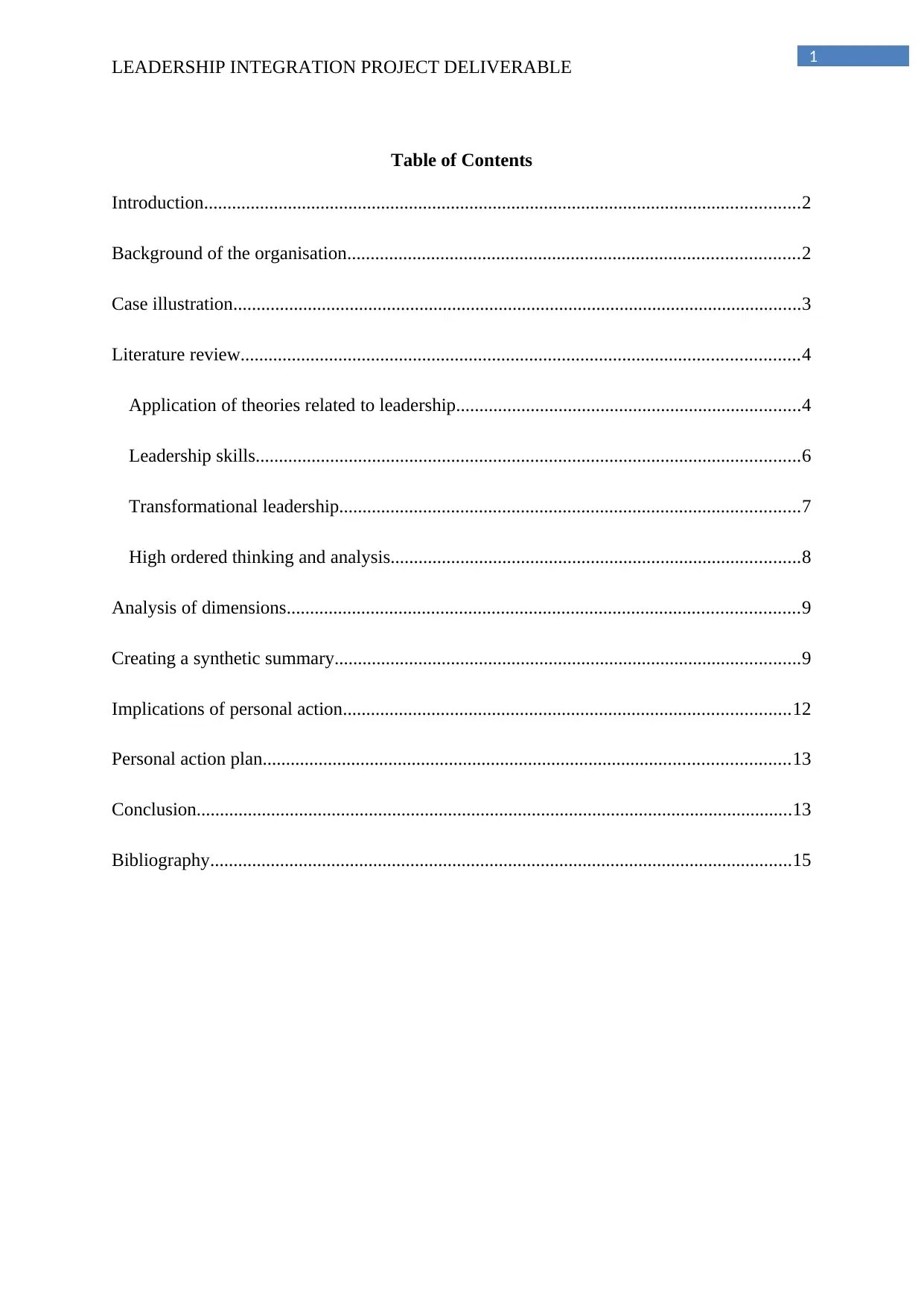
1
LEADERSHIP INTEGRATION PROJECT DELIVERABLE
Table of Contents
Introduction................................................................................................................................2
Background of the organisation.................................................................................................2
Case illustration..........................................................................................................................3
Literature review........................................................................................................................4
Application of theories related to leadership..........................................................................4
Leadership skills.....................................................................................................................6
Transformational leadership...................................................................................................7
High ordered thinking and analysis........................................................................................8
Analysis of dimensions..............................................................................................................9
Creating a synthetic summary....................................................................................................9
Implications of personal action................................................................................................12
Personal action plan.................................................................................................................13
Conclusion................................................................................................................................13
Bibliography.............................................................................................................................15
LEADERSHIP INTEGRATION PROJECT DELIVERABLE
Table of Contents
Introduction................................................................................................................................2
Background of the organisation.................................................................................................2
Case illustration..........................................................................................................................3
Literature review........................................................................................................................4
Application of theories related to leadership..........................................................................4
Leadership skills.....................................................................................................................6
Transformational leadership...................................................................................................7
High ordered thinking and analysis........................................................................................8
Analysis of dimensions..............................................................................................................9
Creating a synthetic summary....................................................................................................9
Implications of personal action................................................................................................12
Personal action plan.................................................................................................................13
Conclusion................................................................................................................................13
Bibliography.............................................................................................................................15
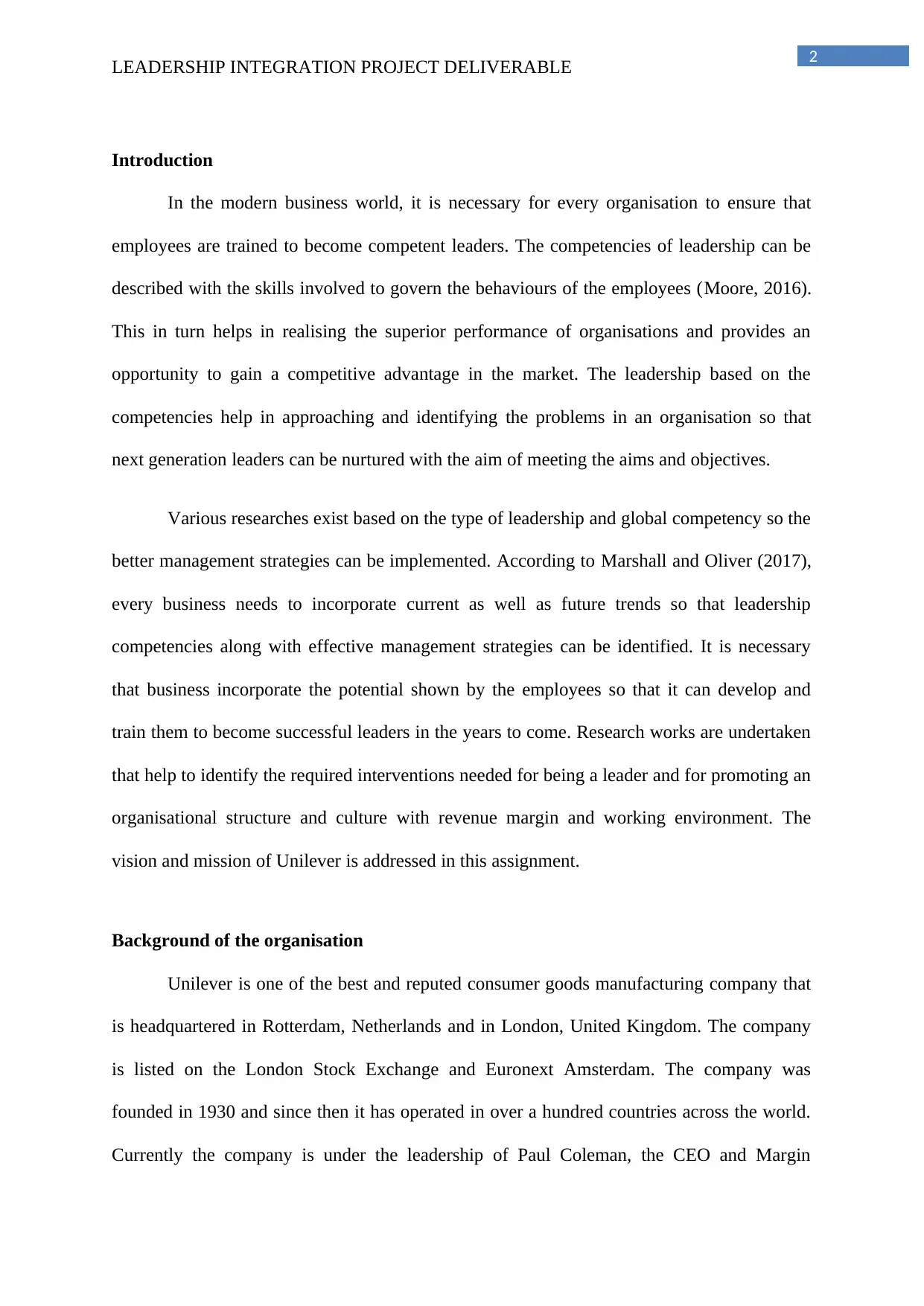
2
LEADERSHIP INTEGRATION PROJECT DELIVERABLE
Introduction
In the modern business world, it is necessary for every organisation to ensure that
employees are trained to become competent leaders. The competencies of leadership can be
described with the skills involved to govern the behaviours of the employees (Moore, 2016).
This in turn helps in realising the superior performance of organisations and provides an
opportunity to gain a competitive advantage in the market. The leadership based on the
competencies help in approaching and identifying the problems in an organisation so that
next generation leaders can be nurtured with the aim of meeting the aims and objectives.
Various researches exist based on the type of leadership and global competency so the
better management strategies can be implemented. According to Marshall and Oliver (2017),
every business needs to incorporate current as well as future trends so that leadership
competencies along with effective management strategies can be identified. It is necessary
that business incorporate the potential shown by the employees so that it can develop and
train them to become successful leaders in the years to come. Research works are undertaken
that help to identify the required interventions needed for being a leader and for promoting an
organisational structure and culture with revenue margin and working environment. The
vision and mission of Unilever is addressed in this assignment.
Background of the organisation
Unilever is one of the best and reputed consumer goods manufacturing company that
is headquartered in Rotterdam, Netherlands and in London, United Kingdom. The company
is listed on the London Stock Exchange and Euronext Amsterdam. The company was
founded in 1930 and since then it has operated in over a hundred countries across the world.
Currently the company is under the leadership of Paul Coleman, the CEO and Margin
LEADERSHIP INTEGRATION PROJECT DELIVERABLE
Introduction
In the modern business world, it is necessary for every organisation to ensure that
employees are trained to become competent leaders. The competencies of leadership can be
described with the skills involved to govern the behaviours of the employees (Moore, 2016).
This in turn helps in realising the superior performance of organisations and provides an
opportunity to gain a competitive advantage in the market. The leadership based on the
competencies help in approaching and identifying the problems in an organisation so that
next generation leaders can be nurtured with the aim of meeting the aims and objectives.
Various researches exist based on the type of leadership and global competency so the
better management strategies can be implemented. According to Marshall and Oliver (2017),
every business needs to incorporate current as well as future trends so that leadership
competencies along with effective management strategies can be identified. It is necessary
that business incorporate the potential shown by the employees so that it can develop and
train them to become successful leaders in the years to come. Research works are undertaken
that help to identify the required interventions needed for being a leader and for promoting an
organisational structure and culture with revenue margin and working environment. The
vision and mission of Unilever is addressed in this assignment.
Background of the organisation
Unilever is one of the best and reputed consumer goods manufacturing company that
is headquartered in Rotterdam, Netherlands and in London, United Kingdom. The company
is listed on the London Stock Exchange and Euronext Amsterdam. The company was
founded in 1930 and since then it has operated in over a hundred countries across the world.
Currently the company is under the leadership of Paul Coleman, the CEO and Margin
⊘ This is a preview!⊘
Do you want full access?
Subscribe today to unlock all pages.

Trusted by 1+ million students worldwide
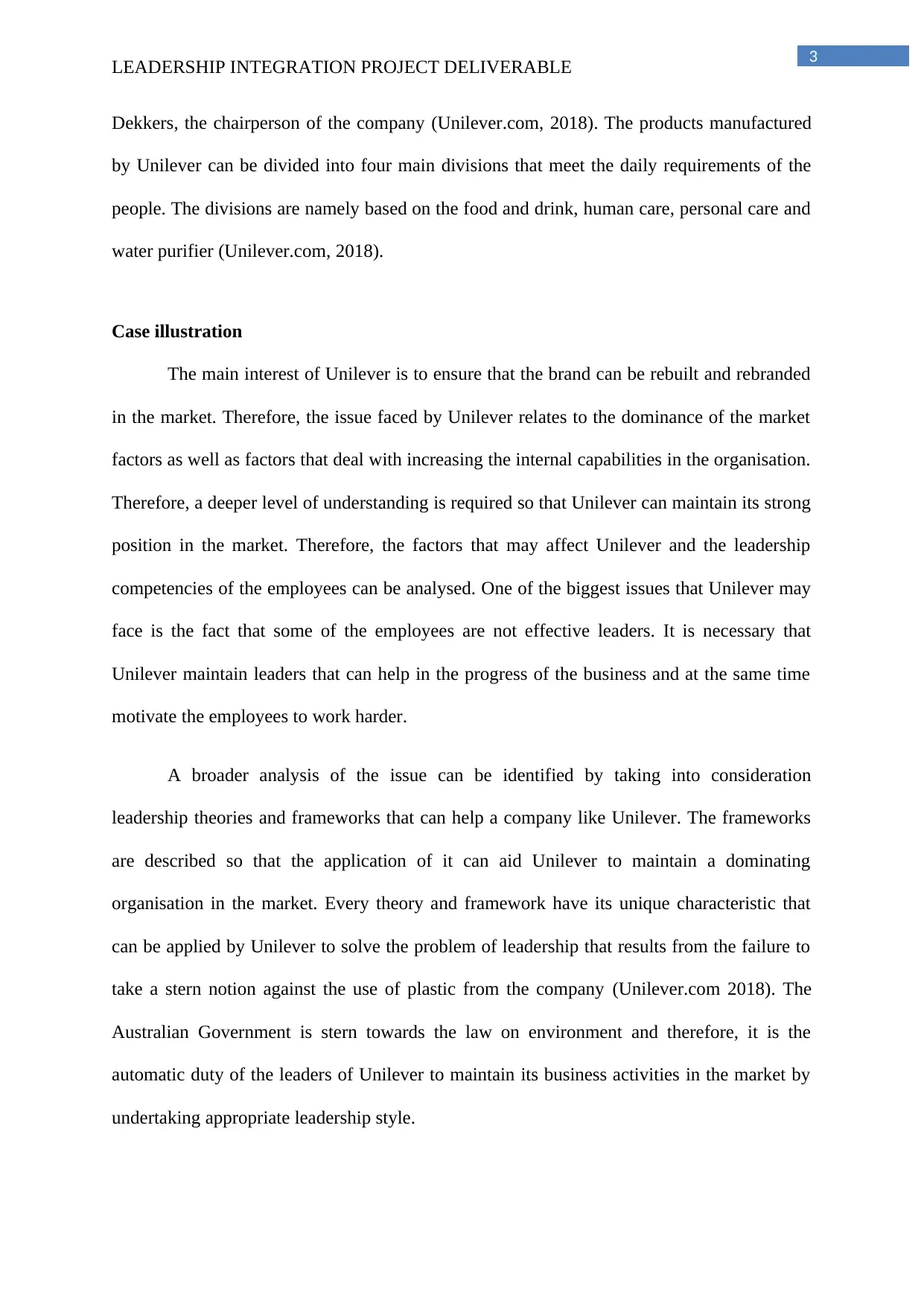
3
LEADERSHIP INTEGRATION PROJECT DELIVERABLE
Dekkers, the chairperson of the company (Unilever.com, 2018). The products manufactured
by Unilever can be divided into four main divisions that meet the daily requirements of the
people. The divisions are namely based on the food and drink, human care, personal care and
water purifier (Unilever.com, 2018).
Case illustration
The main interest of Unilever is to ensure that the brand can be rebuilt and rebranded
in the market. Therefore, the issue faced by Unilever relates to the dominance of the market
factors as well as factors that deal with increasing the internal capabilities in the organisation.
Therefore, a deeper level of understanding is required so that Unilever can maintain its strong
position in the market. Therefore, the factors that may affect Unilever and the leadership
competencies of the employees can be analysed. One of the biggest issues that Unilever may
face is the fact that some of the employees are not effective leaders. It is necessary that
Unilever maintain leaders that can help in the progress of the business and at the same time
motivate the employees to work harder.
A broader analysis of the issue can be identified by taking into consideration
leadership theories and frameworks that can help a company like Unilever. The frameworks
are described so that the application of it can aid Unilever to maintain a dominating
organisation in the market. Every theory and framework have its unique characteristic that
can be applied by Unilever to solve the problem of leadership that results from the failure to
take a stern notion against the use of plastic from the company (Unilever.com 2018). The
Australian Government is stern towards the law on environment and therefore, it is the
automatic duty of the leaders of Unilever to maintain its business activities in the market by
undertaking appropriate leadership style.
LEADERSHIP INTEGRATION PROJECT DELIVERABLE
Dekkers, the chairperson of the company (Unilever.com, 2018). The products manufactured
by Unilever can be divided into four main divisions that meet the daily requirements of the
people. The divisions are namely based on the food and drink, human care, personal care and
water purifier (Unilever.com, 2018).
Case illustration
The main interest of Unilever is to ensure that the brand can be rebuilt and rebranded
in the market. Therefore, the issue faced by Unilever relates to the dominance of the market
factors as well as factors that deal with increasing the internal capabilities in the organisation.
Therefore, a deeper level of understanding is required so that Unilever can maintain its strong
position in the market. Therefore, the factors that may affect Unilever and the leadership
competencies of the employees can be analysed. One of the biggest issues that Unilever may
face is the fact that some of the employees are not effective leaders. It is necessary that
Unilever maintain leaders that can help in the progress of the business and at the same time
motivate the employees to work harder.
A broader analysis of the issue can be identified by taking into consideration
leadership theories and frameworks that can help a company like Unilever. The frameworks
are described so that the application of it can aid Unilever to maintain a dominating
organisation in the market. Every theory and framework have its unique characteristic that
can be applied by Unilever to solve the problem of leadership that results from the failure to
take a stern notion against the use of plastic from the company (Unilever.com 2018). The
Australian Government is stern towards the law on environment and therefore, it is the
automatic duty of the leaders of Unilever to maintain its business activities in the market by
undertaking appropriate leadership style.
Paraphrase This Document
Need a fresh take? Get an instant paraphrase of this document with our AI Paraphraser
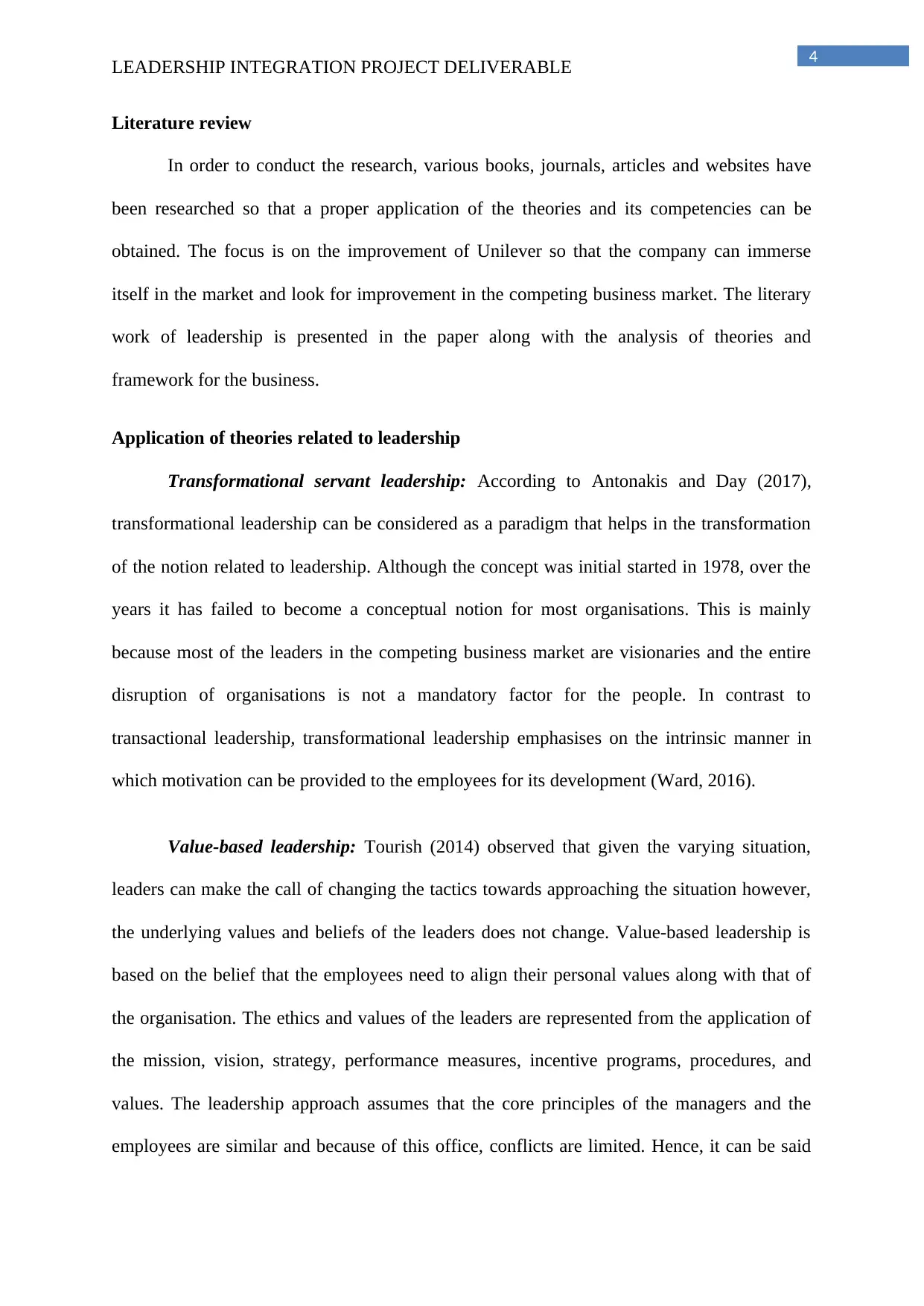
4
LEADERSHIP INTEGRATION PROJECT DELIVERABLE
Literature review
In order to conduct the research, various books, journals, articles and websites have
been researched so that a proper application of the theories and its competencies can be
obtained. The focus is on the improvement of Unilever so that the company can immerse
itself in the market and look for improvement in the competing business market. The literary
work of leadership is presented in the paper along with the analysis of theories and
framework for the business.
Application of theories related to leadership
Transformational servant leadership: According to Antonakis and Day (2017),
transformational leadership can be considered as a paradigm that helps in the transformation
of the notion related to leadership. Although the concept was initial started in 1978, over the
years it has failed to become a conceptual notion for most organisations. This is mainly
because most of the leaders in the competing business market are visionaries and the entire
disruption of organisations is not a mandatory factor for the people. In contrast to
transactional leadership, transformational leadership emphasises on the intrinsic manner in
which motivation can be provided to the employees for its development (Ward, 2016).
Value-based leadership: Tourish (2014) observed that given the varying situation,
leaders can make the call of changing the tactics towards approaching the situation however,
the underlying values and beliefs of the leaders does not change. Value-based leadership is
based on the belief that the employees need to align their personal values along with that of
the organisation. The ethics and values of the leaders are represented from the application of
the mission, vision, strategy, performance measures, incentive programs, procedures, and
values. The leadership approach assumes that the core principles of the managers and the
employees are similar and because of this office, conflicts are limited. Hence, it can be said
LEADERSHIP INTEGRATION PROJECT DELIVERABLE
Literature review
In order to conduct the research, various books, journals, articles and websites have
been researched so that a proper application of the theories and its competencies can be
obtained. The focus is on the improvement of Unilever so that the company can immerse
itself in the market and look for improvement in the competing business market. The literary
work of leadership is presented in the paper along with the analysis of theories and
framework for the business.
Application of theories related to leadership
Transformational servant leadership: According to Antonakis and Day (2017),
transformational leadership can be considered as a paradigm that helps in the transformation
of the notion related to leadership. Although the concept was initial started in 1978, over the
years it has failed to become a conceptual notion for most organisations. This is mainly
because most of the leaders in the competing business market are visionaries and the entire
disruption of organisations is not a mandatory factor for the people. In contrast to
transactional leadership, transformational leadership emphasises on the intrinsic manner in
which motivation can be provided to the employees for its development (Ward, 2016).
Value-based leadership: Tourish (2014) observed that given the varying situation,
leaders can make the call of changing the tactics towards approaching the situation however,
the underlying values and beliefs of the leaders does not change. Value-based leadership is
based on the belief that the employees need to align their personal values along with that of
the organisation. The ethics and values of the leaders are represented from the application of
the mission, vision, strategy, performance measures, incentive programs, procedures, and
values. The leadership approach assumes that the core principles of the managers and the
employees are similar and because of this office, conflicts are limited. Hence, it can be said
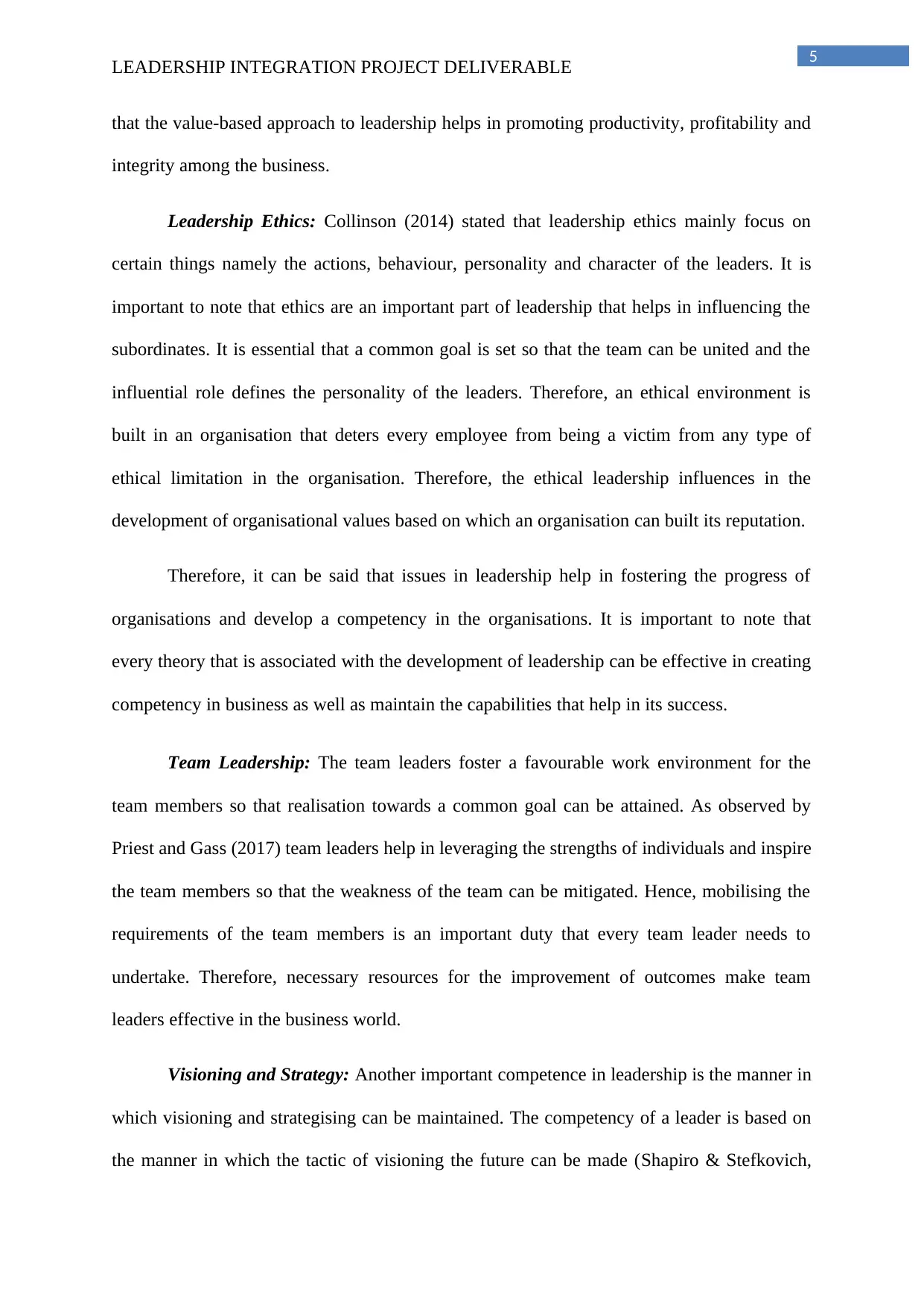
5
LEADERSHIP INTEGRATION PROJECT DELIVERABLE
that the value-based approach to leadership helps in promoting productivity, profitability and
integrity among the business.
Leadership Ethics: Collinson (2014) stated that leadership ethics mainly focus on
certain things namely the actions, behaviour, personality and character of the leaders. It is
important to note that ethics are an important part of leadership that helps in influencing the
subordinates. It is essential that a common goal is set so that the team can be united and the
influential role defines the personality of the leaders. Therefore, an ethical environment is
built in an organisation that deters every employee from being a victim from any type of
ethical limitation in the organisation. Therefore, the ethical leadership influences in the
development of organisational values based on which an organisation can built its reputation.
Therefore, it can be said that issues in leadership help in fostering the progress of
organisations and develop a competency in the organisations. It is important to note that
every theory that is associated with the development of leadership can be effective in creating
competency in business as well as maintain the capabilities that help in its success.
Team Leadership: The team leaders foster a favourable work environment for the
team members so that realisation towards a common goal can be attained. As observed by
Priest and Gass (2017) team leaders help in leveraging the strengths of individuals and inspire
the team members so that the weakness of the team can be mitigated. Hence, mobilising the
requirements of the team members is an important duty that every team leader needs to
undertake. Therefore, necessary resources for the improvement of outcomes make team
leaders effective in the business world.
Visioning and Strategy: Another important competence in leadership is the manner in
which visioning and strategising can be maintained. The competency of a leader is based on
the manner in which the tactic of visioning the future can be made (Shapiro & Stefkovich,
LEADERSHIP INTEGRATION PROJECT DELIVERABLE
that the value-based approach to leadership helps in promoting productivity, profitability and
integrity among the business.
Leadership Ethics: Collinson (2014) stated that leadership ethics mainly focus on
certain things namely the actions, behaviour, personality and character of the leaders. It is
important to note that ethics are an important part of leadership that helps in influencing the
subordinates. It is essential that a common goal is set so that the team can be united and the
influential role defines the personality of the leaders. Therefore, an ethical environment is
built in an organisation that deters every employee from being a victim from any type of
ethical limitation in the organisation. Therefore, the ethical leadership influences in the
development of organisational values based on which an organisation can built its reputation.
Therefore, it can be said that issues in leadership help in fostering the progress of
organisations and develop a competency in the organisations. It is important to note that
every theory that is associated with the development of leadership can be effective in creating
competency in business as well as maintain the capabilities that help in its success.
Team Leadership: The team leaders foster a favourable work environment for the
team members so that realisation towards a common goal can be attained. As observed by
Priest and Gass (2017) team leaders help in leveraging the strengths of individuals and inspire
the team members so that the weakness of the team can be mitigated. Hence, mobilising the
requirements of the team members is an important duty that every team leader needs to
undertake. Therefore, necessary resources for the improvement of outcomes make team
leaders effective in the business world.
Visioning and Strategy: Another important competence in leadership is the manner in
which visioning and strategising can be maintained. The competency of a leader is based on
the manner in which the tactic of visioning the future can be made (Shapiro & Stefkovich,
⊘ This is a preview!⊘
Do you want full access?
Subscribe today to unlock all pages.

Trusted by 1+ million students worldwide
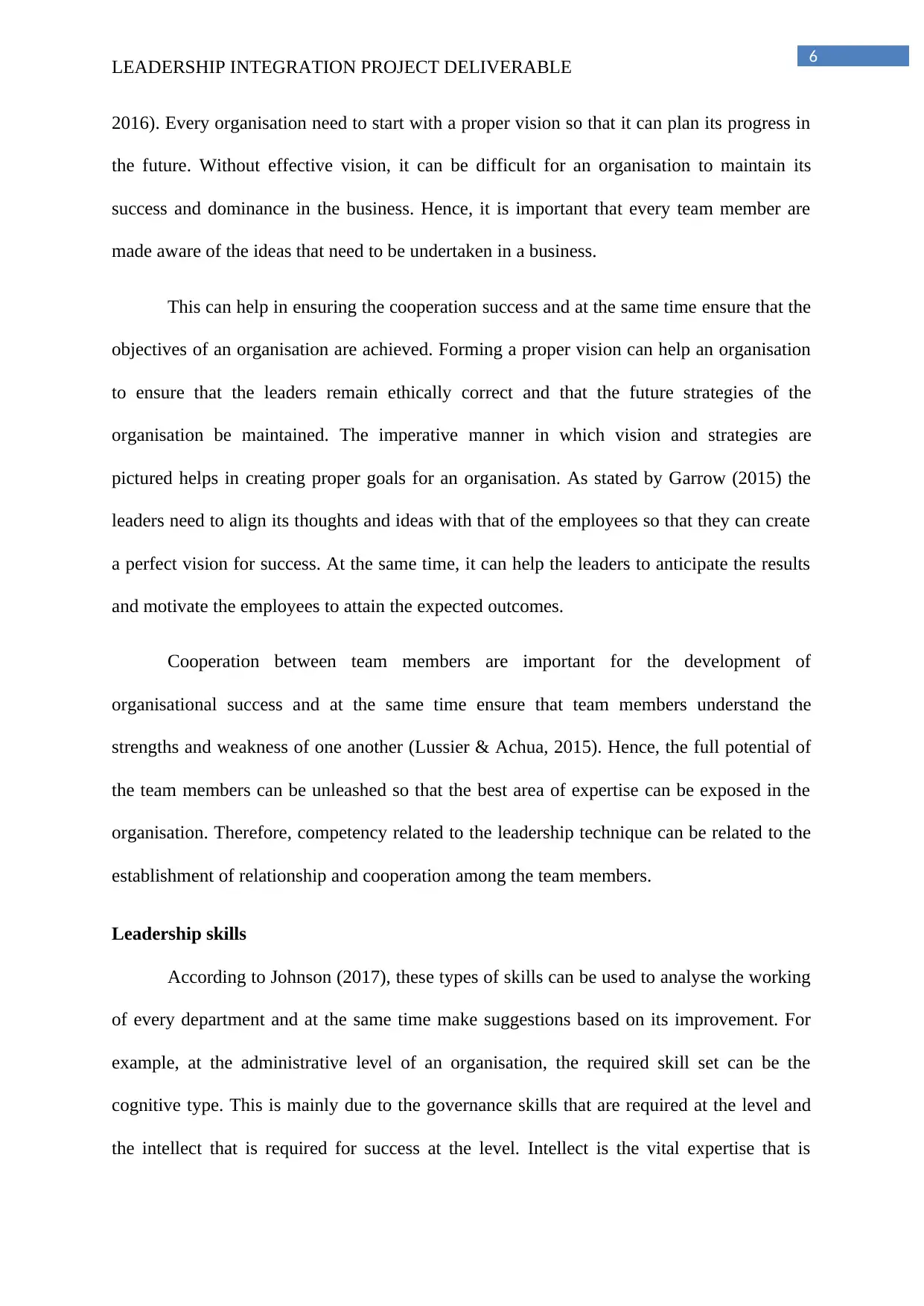
6
LEADERSHIP INTEGRATION PROJECT DELIVERABLE
2016). Every organisation need to start with a proper vision so that it can plan its progress in
the future. Without effective vision, it can be difficult for an organisation to maintain its
success and dominance in the business. Hence, it is important that every team member are
made aware of the ideas that need to be undertaken in a business.
This can help in ensuring the cooperation success and at the same time ensure that the
objectives of an organisation are achieved. Forming a proper vision can help an organisation
to ensure that the leaders remain ethically correct and that the future strategies of the
organisation be maintained. The imperative manner in which vision and strategies are
pictured helps in creating proper goals for an organisation. As stated by Garrow (2015) the
leaders need to align its thoughts and ideas with that of the employees so that they can create
a perfect vision for success. At the same time, it can help the leaders to anticipate the results
and motivate the employees to attain the expected outcomes.
Cooperation between team members are important for the development of
organisational success and at the same time ensure that team members understand the
strengths and weakness of one another (Lussier & Achua, 2015). Hence, the full potential of
the team members can be unleashed so that the best area of expertise can be exposed in the
organisation. Therefore, competency related to the leadership technique can be related to the
establishment of relationship and cooperation among the team members.
Leadership skills
According to Johnson (2017), these types of skills can be used to analyse the working
of every department and at the same time make suggestions based on its improvement. For
example, at the administrative level of an organisation, the required skill set can be the
cognitive type. This is mainly due to the governance skills that are required at the level and
the intellect that is required for success at the level. Intellect is the vital expertise that is
LEADERSHIP INTEGRATION PROJECT DELIVERABLE
2016). Every organisation need to start with a proper vision so that it can plan its progress in
the future. Without effective vision, it can be difficult for an organisation to maintain its
success and dominance in the business. Hence, it is important that every team member are
made aware of the ideas that need to be undertaken in a business.
This can help in ensuring the cooperation success and at the same time ensure that the
objectives of an organisation are achieved. Forming a proper vision can help an organisation
to ensure that the leaders remain ethically correct and that the future strategies of the
organisation be maintained. The imperative manner in which vision and strategies are
pictured helps in creating proper goals for an organisation. As stated by Garrow (2015) the
leaders need to align its thoughts and ideas with that of the employees so that they can create
a perfect vision for success. At the same time, it can help the leaders to anticipate the results
and motivate the employees to attain the expected outcomes.
Cooperation between team members are important for the development of
organisational success and at the same time ensure that team members understand the
strengths and weakness of one another (Lussier & Achua, 2015). Hence, the full potential of
the team members can be unleashed so that the best area of expertise can be exposed in the
organisation. Therefore, competency related to the leadership technique can be related to the
establishment of relationship and cooperation among the team members.
Leadership skills
According to Johnson (2017), these types of skills can be used to analyse the working
of every department and at the same time make suggestions based on its improvement. For
example, at the administrative level of an organisation, the required skill set can be the
cognitive type. This is mainly due to the governance skills that are required at the level and
the intellect that is required for success at the level. Intellect is the vital expertise that is
Paraphrase This Document
Need a fresh take? Get an instant paraphrase of this document with our AI Paraphraser
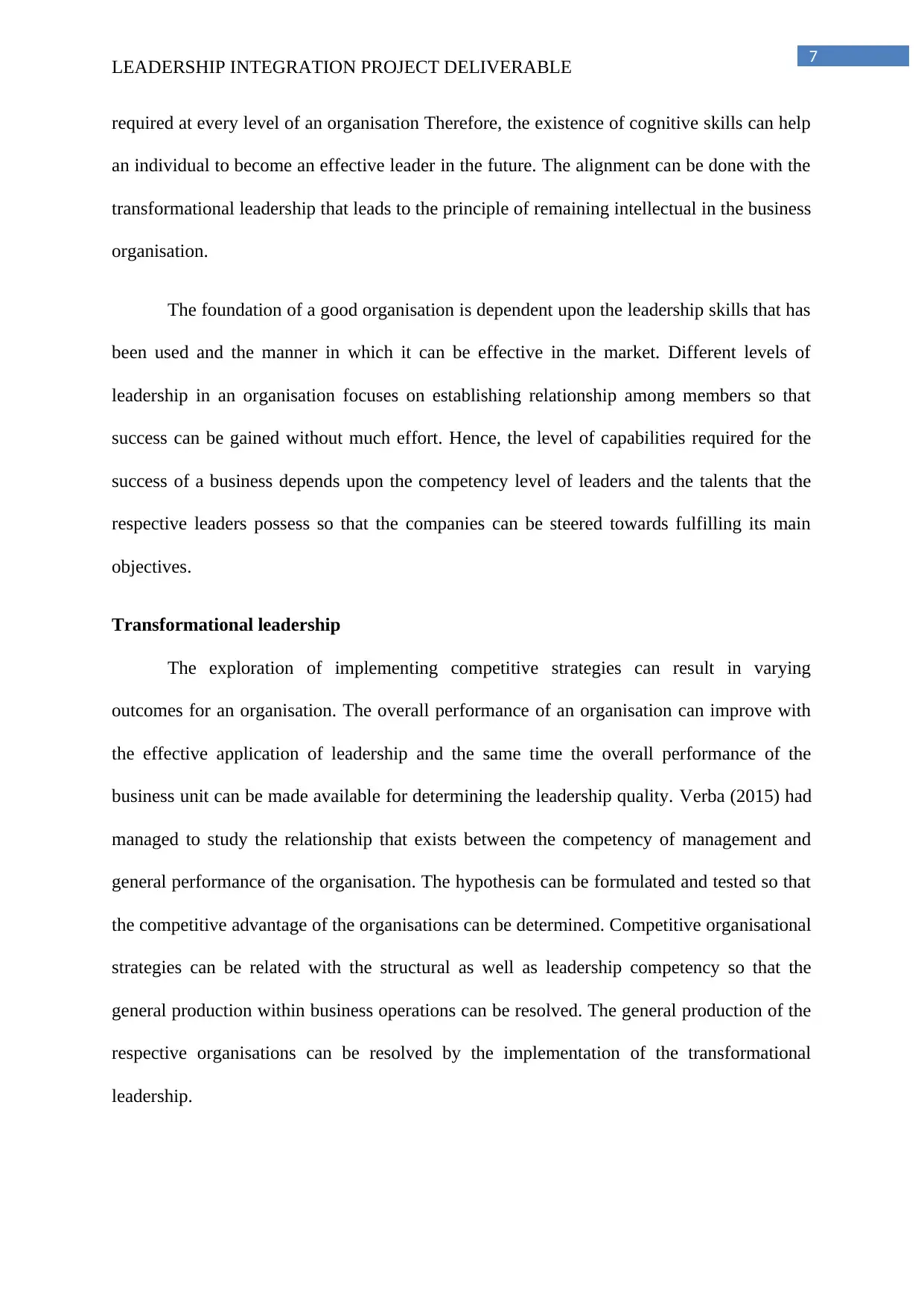
7
LEADERSHIP INTEGRATION PROJECT DELIVERABLE
required at every level of an organisation Therefore, the existence of cognitive skills can help
an individual to become an effective leader in the future. The alignment can be done with the
transformational leadership that leads to the principle of remaining intellectual in the business
organisation.
The foundation of a good organisation is dependent upon the leadership skills that has
been used and the manner in which it can be effective in the market. Different levels of
leadership in an organisation focuses on establishing relationship among members so that
success can be gained without much effort. Hence, the level of capabilities required for the
success of a business depends upon the competency level of leaders and the talents that the
respective leaders possess so that the companies can be steered towards fulfilling its main
objectives.
Transformational leadership
The exploration of implementing competitive strategies can result in varying
outcomes for an organisation. The overall performance of an organisation can improve with
the effective application of leadership and the same time the overall performance of the
business unit can be made available for determining the leadership quality. Verba (2015) had
managed to study the relationship that exists between the competency of management and
general performance of the organisation. The hypothesis can be formulated and tested so that
the competitive advantage of the organisations can be determined. Competitive organisational
strategies can be related with the structural as well as leadership competency so that the
general production within business operations can be resolved. The general production of the
respective organisations can be resolved by the implementation of the transformational
leadership.
LEADERSHIP INTEGRATION PROJECT DELIVERABLE
required at every level of an organisation Therefore, the existence of cognitive skills can help
an individual to become an effective leader in the future. The alignment can be done with the
transformational leadership that leads to the principle of remaining intellectual in the business
organisation.
The foundation of a good organisation is dependent upon the leadership skills that has
been used and the manner in which it can be effective in the market. Different levels of
leadership in an organisation focuses on establishing relationship among members so that
success can be gained without much effort. Hence, the level of capabilities required for the
success of a business depends upon the competency level of leaders and the talents that the
respective leaders possess so that the companies can be steered towards fulfilling its main
objectives.
Transformational leadership
The exploration of implementing competitive strategies can result in varying
outcomes for an organisation. The overall performance of an organisation can improve with
the effective application of leadership and the same time the overall performance of the
business unit can be made available for determining the leadership quality. Verba (2015) had
managed to study the relationship that exists between the competency of management and
general performance of the organisation. The hypothesis can be formulated and tested so that
the competitive advantage of the organisations can be determined. Competitive organisational
strategies can be related with the structural as well as leadership competency so that the
general production within business operations can be resolved. The general production of the
respective organisations can be resolved by the implementation of the transformational
leadership.
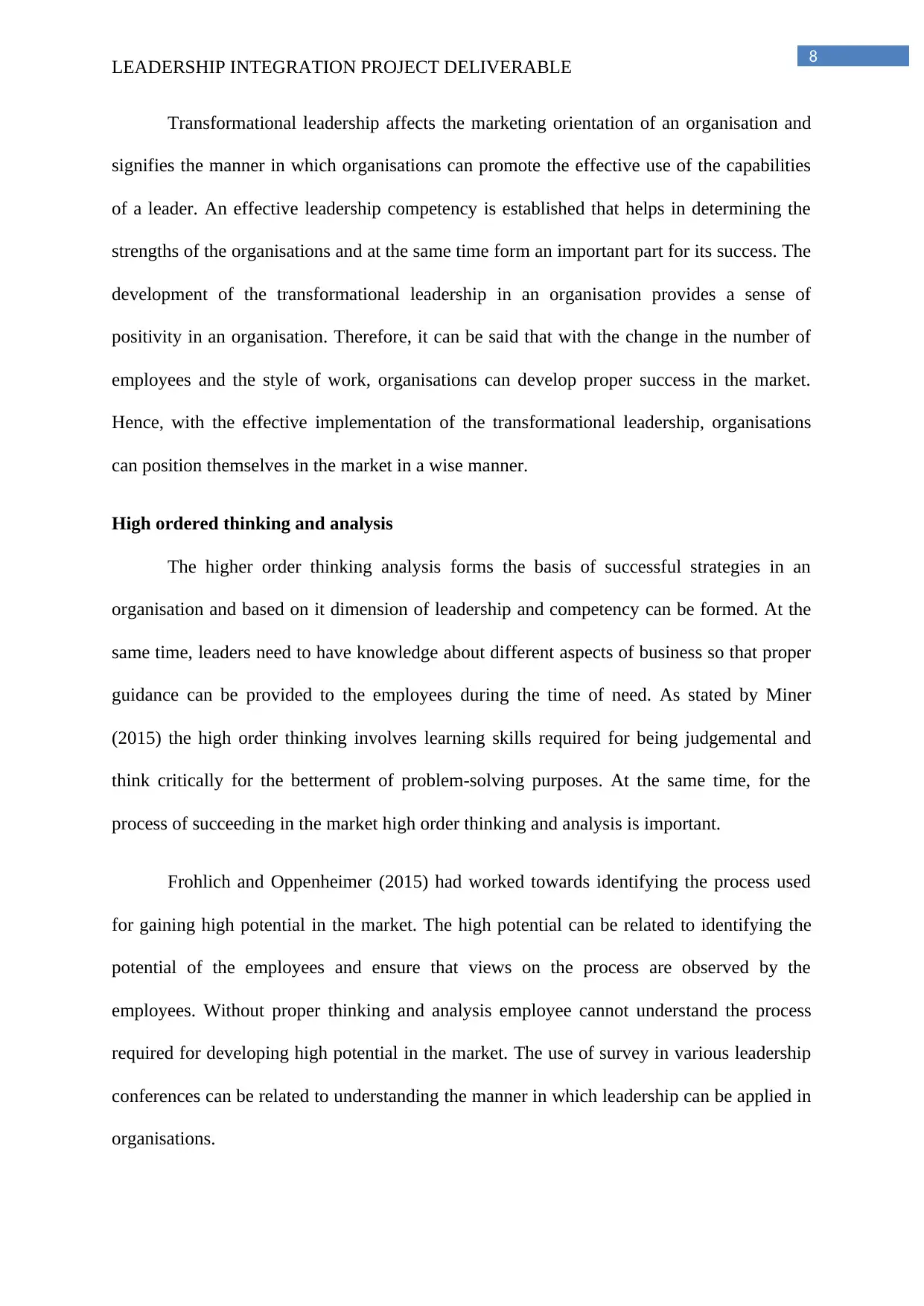
8
LEADERSHIP INTEGRATION PROJECT DELIVERABLE
Transformational leadership affects the marketing orientation of an organisation and
signifies the manner in which organisations can promote the effective use of the capabilities
of a leader. An effective leadership competency is established that helps in determining the
strengths of the organisations and at the same time form an important part for its success. The
development of the transformational leadership in an organisation provides a sense of
positivity in an organisation. Therefore, it can be said that with the change in the number of
employees and the style of work, organisations can develop proper success in the market.
Hence, with the effective implementation of the transformational leadership, organisations
can position themselves in the market in a wise manner.
High ordered thinking and analysis
The higher order thinking analysis forms the basis of successful strategies in an
organisation and based on it dimension of leadership and competency can be formed. At the
same time, leaders need to have knowledge about different aspects of business so that proper
guidance can be provided to the employees during the time of need. As stated by Miner
(2015) the high order thinking involves learning skills required for being judgemental and
think critically for the betterment of problem-solving purposes. At the same time, for the
process of succeeding in the market high order thinking and analysis is important.
Frohlich and Oppenheimer (2015) had worked towards identifying the process used
for gaining high potential in the market. The high potential can be related to identifying the
potential of the employees and ensure that views on the process are observed by the
employees. Without proper thinking and analysis employee cannot understand the process
required for developing high potential in the market. The use of survey in various leadership
conferences can be related to understanding the manner in which leadership can be applied in
organisations.
LEADERSHIP INTEGRATION PROJECT DELIVERABLE
Transformational leadership affects the marketing orientation of an organisation and
signifies the manner in which organisations can promote the effective use of the capabilities
of a leader. An effective leadership competency is established that helps in determining the
strengths of the organisations and at the same time form an important part for its success. The
development of the transformational leadership in an organisation provides a sense of
positivity in an organisation. Therefore, it can be said that with the change in the number of
employees and the style of work, organisations can develop proper success in the market.
Hence, with the effective implementation of the transformational leadership, organisations
can position themselves in the market in a wise manner.
High ordered thinking and analysis
The higher order thinking analysis forms the basis of successful strategies in an
organisation and based on it dimension of leadership and competency can be formed. At the
same time, leaders need to have knowledge about different aspects of business so that proper
guidance can be provided to the employees during the time of need. As stated by Miner
(2015) the high order thinking involves learning skills required for being judgemental and
think critically for the betterment of problem-solving purposes. At the same time, for the
process of succeeding in the market high order thinking and analysis is important.
Frohlich and Oppenheimer (2015) had worked towards identifying the process used
for gaining high potential in the market. The high potential can be related to identifying the
potential of the employees and ensure that views on the process are observed by the
employees. Without proper thinking and analysis employee cannot understand the process
required for developing high potential in the market. The use of survey in various leadership
conferences can be related to understanding the manner in which leadership can be applied in
organisations.
⊘ This is a preview!⊘
Do you want full access?
Subscribe today to unlock all pages.

Trusted by 1+ million students worldwide
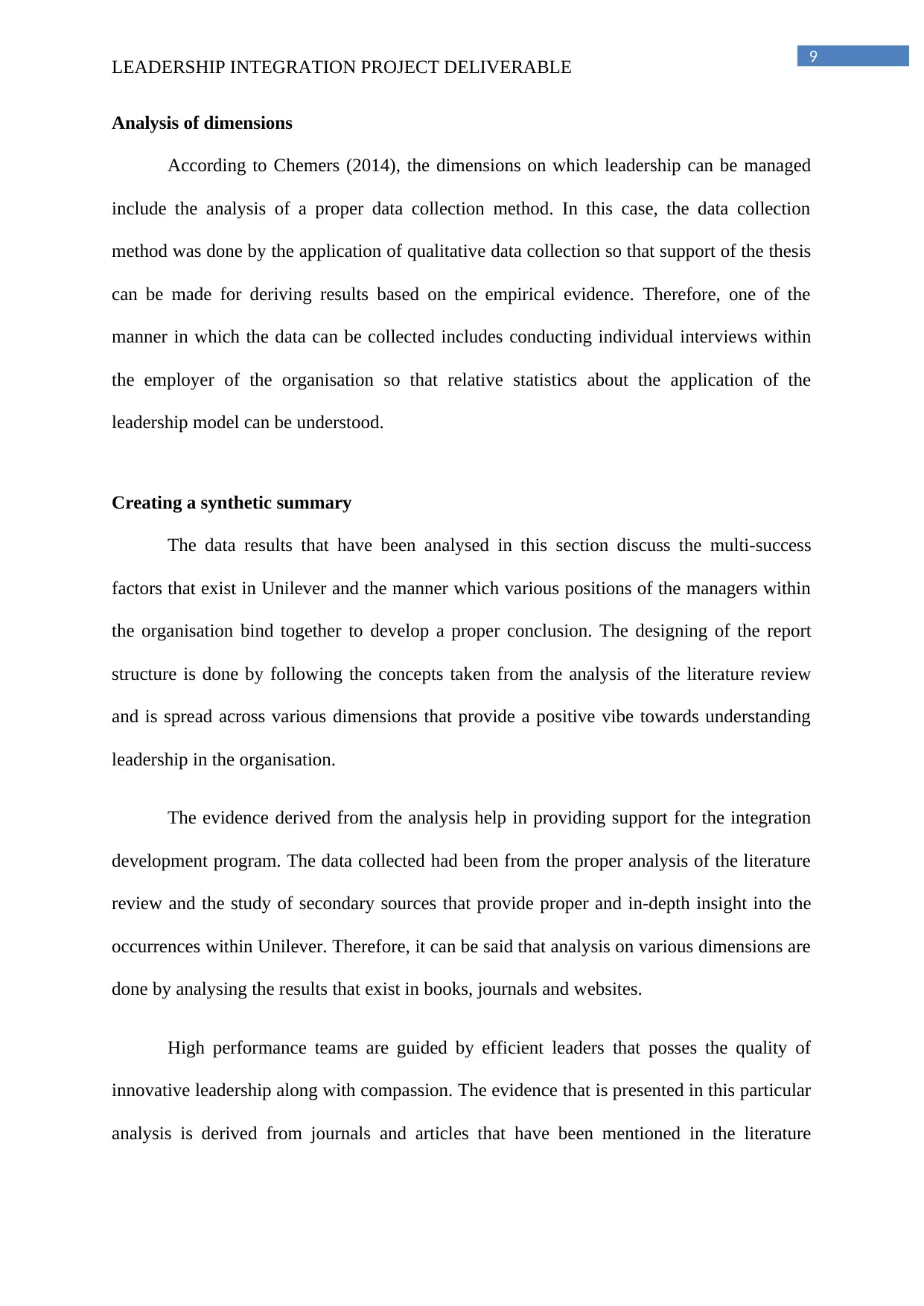
9
LEADERSHIP INTEGRATION PROJECT DELIVERABLE
Analysis of dimensions
According to Chemers (2014), the dimensions on which leadership can be managed
include the analysis of a proper data collection method. In this case, the data collection
method was done by the application of qualitative data collection so that support of the thesis
can be made for deriving results based on the empirical evidence. Therefore, one of the
manner in which the data can be collected includes conducting individual interviews within
the employer of the organisation so that relative statistics about the application of the
leadership model can be understood.
Creating a synthetic summary
The data results that have been analysed in this section discuss the multi-success
factors that exist in Unilever and the manner which various positions of the managers within
the organisation bind together to develop a proper conclusion. The designing of the report
structure is done by following the concepts taken from the analysis of the literature review
and is spread across various dimensions that provide a positive vibe towards understanding
leadership in the organisation.
The evidence derived from the analysis help in providing support for the integration
development program. The data collected had been from the proper analysis of the literature
review and the study of secondary sources that provide proper and in-depth insight into the
occurrences within Unilever. Therefore, it can be said that analysis on various dimensions are
done by analysing the results that exist in books, journals and websites.
High performance teams are guided by efficient leaders that posses the quality of
innovative leadership along with compassion. The evidence that is presented in this particular
analysis is derived from journals and articles that have been mentioned in the literature
LEADERSHIP INTEGRATION PROJECT DELIVERABLE
Analysis of dimensions
According to Chemers (2014), the dimensions on which leadership can be managed
include the analysis of a proper data collection method. In this case, the data collection
method was done by the application of qualitative data collection so that support of the thesis
can be made for deriving results based on the empirical evidence. Therefore, one of the
manner in which the data can be collected includes conducting individual interviews within
the employer of the organisation so that relative statistics about the application of the
leadership model can be understood.
Creating a synthetic summary
The data results that have been analysed in this section discuss the multi-success
factors that exist in Unilever and the manner which various positions of the managers within
the organisation bind together to develop a proper conclusion. The designing of the report
structure is done by following the concepts taken from the analysis of the literature review
and is spread across various dimensions that provide a positive vibe towards understanding
leadership in the organisation.
The evidence derived from the analysis help in providing support for the integration
development program. The data collected had been from the proper analysis of the literature
review and the study of secondary sources that provide proper and in-depth insight into the
occurrences within Unilever. Therefore, it can be said that analysis on various dimensions are
done by analysing the results that exist in books, journals and websites.
High performance teams are guided by efficient leaders that posses the quality of
innovative leadership along with compassion. The evidence that is presented in this particular
analysis is derived from journals and articles that have been mentioned in the literature
Paraphrase This Document
Need a fresh take? Get an instant paraphrase of this document with our AI Paraphraser
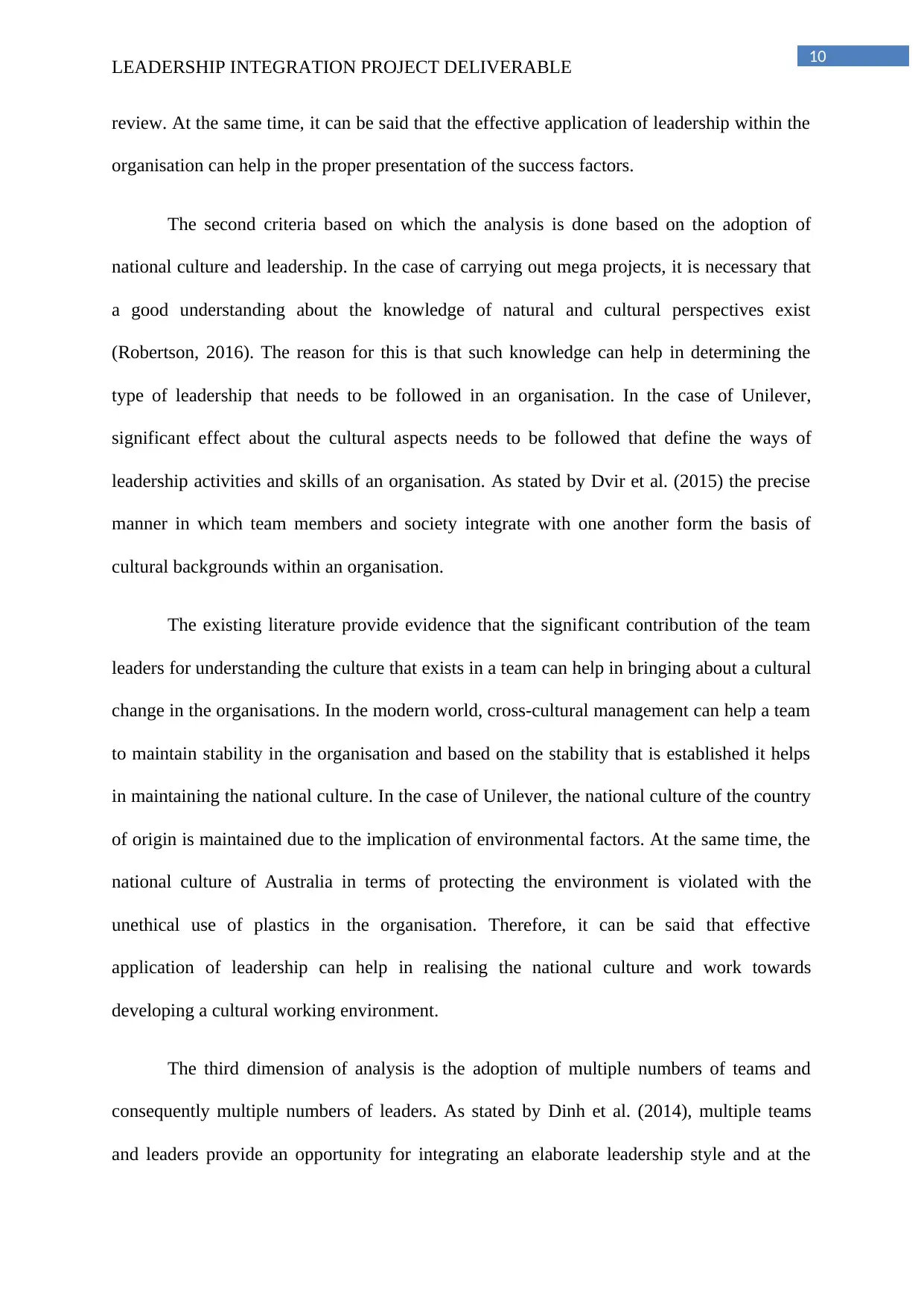
10
LEADERSHIP INTEGRATION PROJECT DELIVERABLE
review. At the same time, it can be said that the effective application of leadership within the
organisation can help in the proper presentation of the success factors.
The second criteria based on which the analysis is done based on the adoption of
national culture and leadership. In the case of carrying out mega projects, it is necessary that
a good understanding about the knowledge of natural and cultural perspectives exist
(Robertson, 2016). The reason for this is that such knowledge can help in determining the
type of leadership that needs to be followed in an organisation. In the case of Unilever,
significant effect about the cultural aspects needs to be followed that define the ways of
leadership activities and skills of an organisation. As stated by Dvir et al. (2015) the precise
manner in which team members and society integrate with one another form the basis of
cultural backgrounds within an organisation.
The existing literature provide evidence that the significant contribution of the team
leaders for understanding the culture that exists in a team can help in bringing about a cultural
change in the organisations. In the modern world, cross-cultural management can help a team
to maintain stability in the organisation and based on the stability that is established it helps
in maintaining the national culture. In the case of Unilever, the national culture of the country
of origin is maintained due to the implication of environmental factors. At the same time, the
national culture of Australia in terms of protecting the environment is violated with the
unethical use of plastics in the organisation. Therefore, it can be said that effective
application of leadership can help in realising the national culture and work towards
developing a cultural working environment.
The third dimension of analysis is the adoption of multiple numbers of teams and
consequently multiple numbers of leaders. As stated by Dinh et al. (2014), multiple teams
and leaders provide an opportunity for integrating an elaborate leadership style and at the
LEADERSHIP INTEGRATION PROJECT DELIVERABLE
review. At the same time, it can be said that the effective application of leadership within the
organisation can help in the proper presentation of the success factors.
The second criteria based on which the analysis is done based on the adoption of
national culture and leadership. In the case of carrying out mega projects, it is necessary that
a good understanding about the knowledge of natural and cultural perspectives exist
(Robertson, 2016). The reason for this is that such knowledge can help in determining the
type of leadership that needs to be followed in an organisation. In the case of Unilever,
significant effect about the cultural aspects needs to be followed that define the ways of
leadership activities and skills of an organisation. As stated by Dvir et al. (2015) the precise
manner in which team members and society integrate with one another form the basis of
cultural backgrounds within an organisation.
The existing literature provide evidence that the significant contribution of the team
leaders for understanding the culture that exists in a team can help in bringing about a cultural
change in the organisations. In the modern world, cross-cultural management can help a team
to maintain stability in the organisation and based on the stability that is established it helps
in maintaining the national culture. In the case of Unilever, the national culture of the country
of origin is maintained due to the implication of environmental factors. At the same time, the
national culture of Australia in terms of protecting the environment is violated with the
unethical use of plastics in the organisation. Therefore, it can be said that effective
application of leadership can help in realising the national culture and work towards
developing a cultural working environment.
The third dimension of analysis is the adoption of multiple numbers of teams and
consequently multiple numbers of leaders. As stated by Dinh et al. (2014), multiple teams
and leaders provide an opportunity for integrating an elaborate leadership style and at the
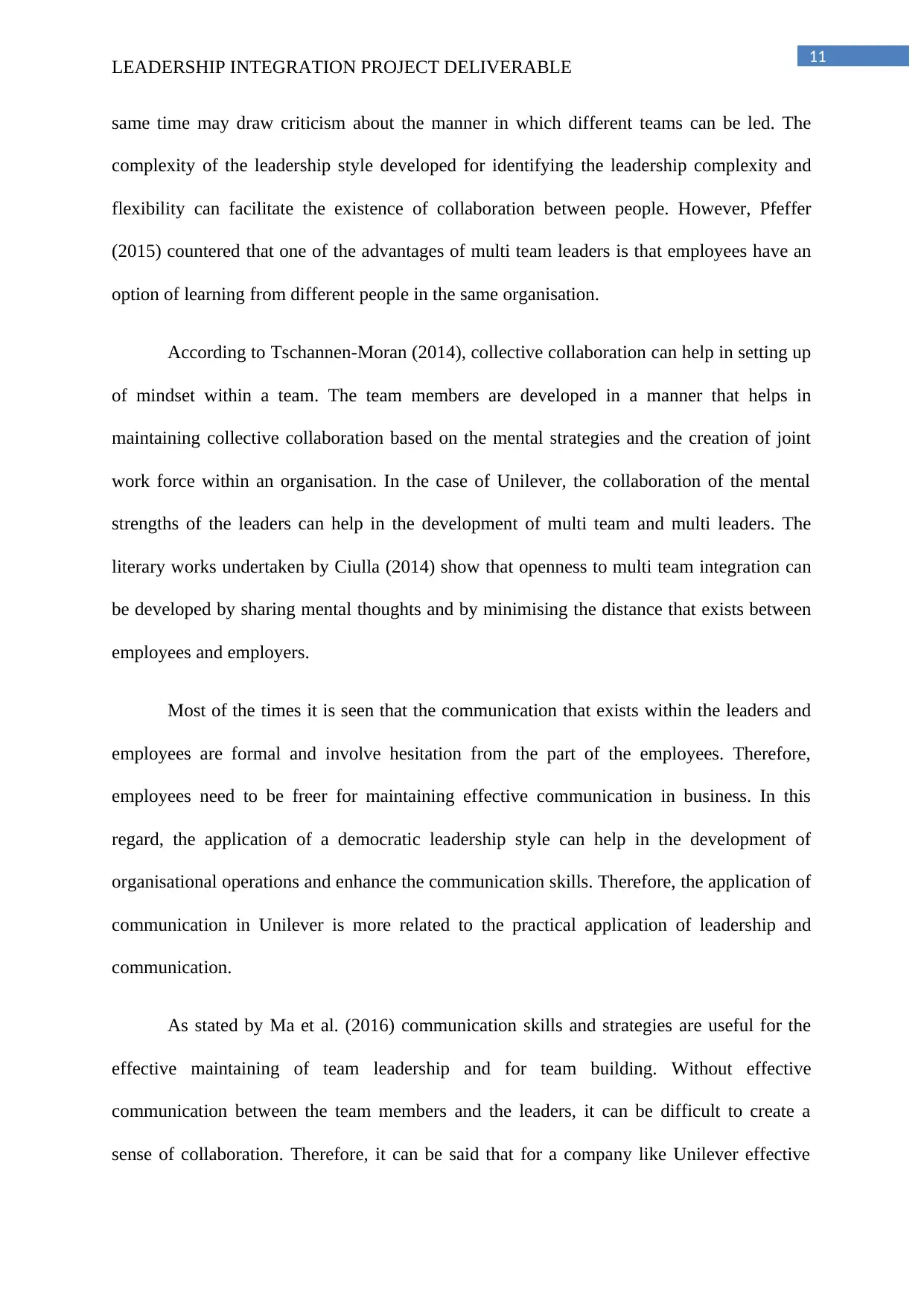
11
LEADERSHIP INTEGRATION PROJECT DELIVERABLE
same time may draw criticism about the manner in which different teams can be led. The
complexity of the leadership style developed for identifying the leadership complexity and
flexibility can facilitate the existence of collaboration between people. However, Pfeffer
(2015) countered that one of the advantages of multi team leaders is that employees have an
option of learning from different people in the same organisation.
According to Tschannen-Moran (2014), collective collaboration can help in setting up
of mindset within a team. The team members are developed in a manner that helps in
maintaining collective collaboration based on the mental strategies and the creation of joint
work force within an organisation. In the case of Unilever, the collaboration of the mental
strengths of the leaders can help in the development of multi team and multi leaders. The
literary works undertaken by Ciulla (2014) show that openness to multi team integration can
be developed by sharing mental thoughts and by minimising the distance that exists between
employees and employers.
Most of the times it is seen that the communication that exists within the leaders and
employees are formal and involve hesitation from the part of the employees. Therefore,
employees need to be freer for maintaining effective communication in business. In this
regard, the application of a democratic leadership style can help in the development of
organisational operations and enhance the communication skills. Therefore, the application of
communication in Unilever is more related to the practical application of leadership and
communication.
As stated by Ma et al. (2016) communication skills and strategies are useful for the
effective maintaining of team leadership and for team building. Without effective
communication between the team members and the leaders, it can be difficult to create a
sense of collaboration. Therefore, it can be said that for a company like Unilever effective
LEADERSHIP INTEGRATION PROJECT DELIVERABLE
same time may draw criticism about the manner in which different teams can be led. The
complexity of the leadership style developed for identifying the leadership complexity and
flexibility can facilitate the existence of collaboration between people. However, Pfeffer
(2015) countered that one of the advantages of multi team leaders is that employees have an
option of learning from different people in the same organisation.
According to Tschannen-Moran (2014), collective collaboration can help in setting up
of mindset within a team. The team members are developed in a manner that helps in
maintaining collective collaboration based on the mental strategies and the creation of joint
work force within an organisation. In the case of Unilever, the collaboration of the mental
strengths of the leaders can help in the development of multi team and multi leaders. The
literary works undertaken by Ciulla (2014) show that openness to multi team integration can
be developed by sharing mental thoughts and by minimising the distance that exists between
employees and employers.
Most of the times it is seen that the communication that exists within the leaders and
employees are formal and involve hesitation from the part of the employees. Therefore,
employees need to be freer for maintaining effective communication in business. In this
regard, the application of a democratic leadership style can help in the development of
organisational operations and enhance the communication skills. Therefore, the application of
communication in Unilever is more related to the practical application of leadership and
communication.
As stated by Ma et al. (2016) communication skills and strategies are useful for the
effective maintaining of team leadership and for team building. Without effective
communication between the team members and the leaders, it can be difficult to create a
sense of collaboration. Therefore, it can be said that for a company like Unilever effective
⊘ This is a preview!⊘
Do you want full access?
Subscribe today to unlock all pages.

Trusted by 1+ million students worldwide
1 out of 21
Related Documents
Your All-in-One AI-Powered Toolkit for Academic Success.
+13062052269
info@desklib.com
Available 24*7 on WhatsApp / Email
![[object Object]](/_next/static/media/star-bottom.7253800d.svg)
Unlock your academic potential
Copyright © 2020–2025 A2Z Services. All Rights Reserved. Developed and managed by ZUCOL.



